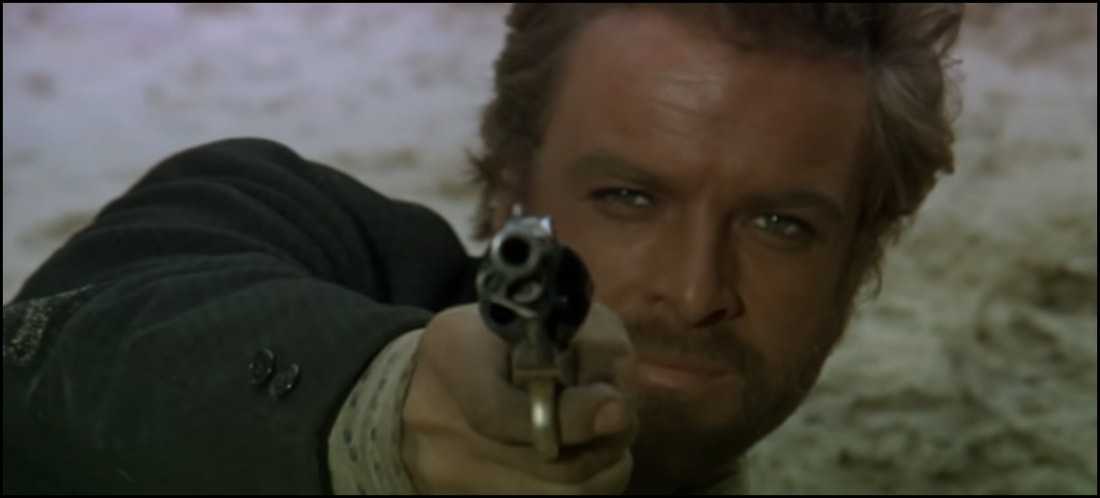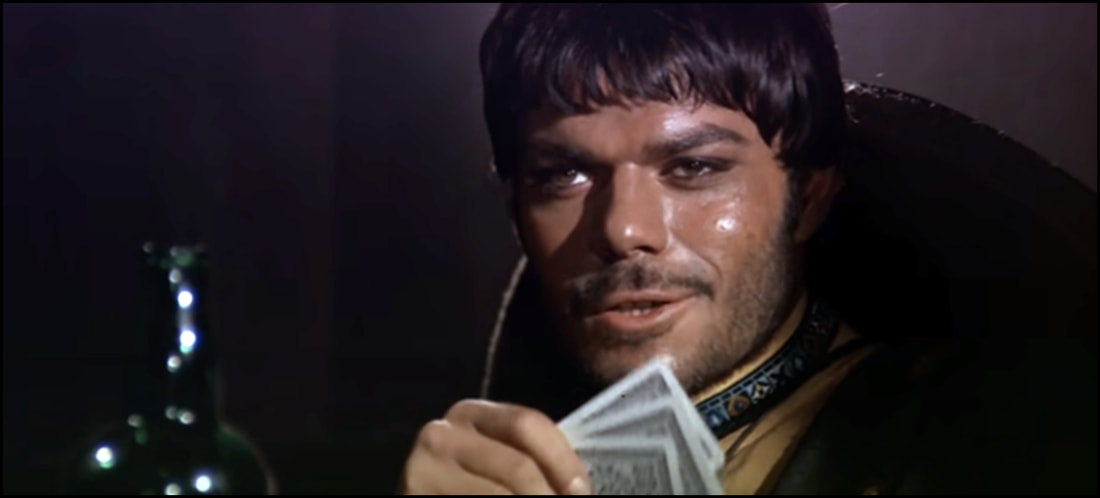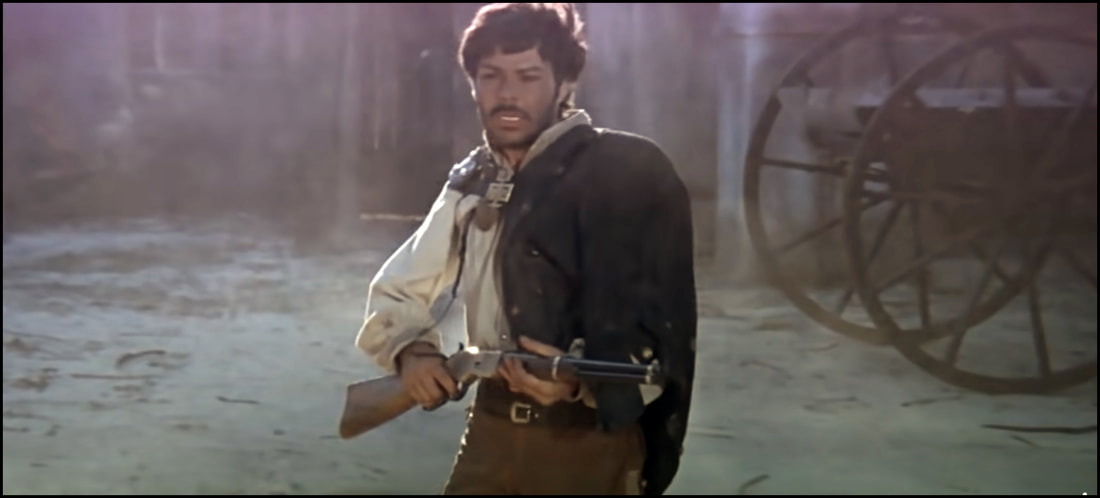And that’s the thing? Westerns don’t have to be epic in scale to, simply, be good.
Not each and every film of the genre need approach the greatness of Sergio Leone’s The Good, The Bad, And The Ugly (1966) to merely be watchable. Not every flick need to have the crowd-pleasing goodness of Rio Bravo (1959) to be entertaining. Not every experience must seek out and deliver old school justice (and vengeance) in the manner that Unforgiven (1992) did to be embraced by audiences around the world. Because these productions are understandably formulaic in nature, all they need to accomplish in order to be good is to show up, have respectable production values, hit their marks, and ride off into the sunset. Yes, it would be a grand, grand world if every attempt to explore these wild days gone by could be exceptional at each opportunity; but – in the scheme of things – I’ve always found that even the category’s color-by-numbers attempts to have something to offer by just being G-O-O-D.
With that preamble out of the way, I’m thrilled to mention that the good people at Arrow Films have provided me with a complimentary copy of their Blood Money: Four Western Classics – Volume 2 that will be released to the home video marketplace on July 25, 2023. The collection includes four spaghetti Westerns – Romolo Guerrieri’s $10,000 Blood Money (1967); Giovanni Fago’s Vengeance Is Mine (1967); Giuliano Carnimeo’s Find A Place To Die (1968); and Cesare Canevari’s Matalo! (Kill Him) (1970). Knowing what I do about spaghetti Westerns – and the highs and lows of films in general – I don’t expect all of them to be fantastic. I do, at a bare minimum, go in hoping for simply goodness; and this helps me find balance in the process of being a critic. Hopefully, I’ll not be disappointed.
First up: $10,000 Blood Money is a Django-inspired showdown that pits one of the Old West’s most revered gunslingers in pursuit of a hardened criminal. Before all is said and done, our enemies will turn frenemies until reaching for the respective six-shooters and taking aim – finally – at one another, deservedly so. It’s a tale best told in bullets – thankfully in ample supply here – so long as there’s one more in chamber worth firing.
From the film’s IMDB.com page citation:
“Django has become a bounty hunter who is asked to chase a villain who has kidnapped a young girl. Because he is not offered enough money, he decides to join forces with the bandit but he’s double-crossed by the ruthless villain.”
In order to fully appreciate the goodness inherent within $10,000 Blood Money, I find it necessary to provide a brief education on two key points: (1) the Spaghetti Western, and (2) Django.
First, the Spaghetti Western is a term applied to classic oaters shot, largely but not exclusively, in Italy. More often than not, these films were produced and/or directed by Italians; and this is chiefly why the ‘spaghetti’ has been added. No, this was never intended in any way as a slight; rather, it was simply to establish that – from both narrative and aesthetic standpoints – there were fundamental differences beyond geography that kinda/sorta distinguished traditional American Westerns from their European counterparts. Though there could be considered more variations – trust me when I say a pretty good deal has been written about them including tricks and tactics filmmakers employed that may or may not have been used to dupe audiences into thinking one was the other – this foundation is truly all that’s needed for my purposes in this space.
Second, the Wild West character of Django was introduced to all of filmdom in the 1966 Spaghetti Western of the same name. Played by Franco Nero, this former Union soldier takes to the plains in what was said to be one of the most violent films to emerge from the 1960’s, establishing the drifter firmly as one of the screen’s signature anti-heroes. Indeed, so popular and profitable was this singular creation that – as of today’s date – Wikipedia.org reports that there have been over thirty official and/or unofficial sequels exploring the further tales of the gunfighter … and this brings us to 1967’s $10,000 Blood Money.
Directed by Romolo Guerrieri (who happens to be the uncle to genre auteur Enzo G. Castellari), Blood Money establishes that Django (played by Gianni Garko under the name of ‘Gary Hudson’) has taken up the business of bounty hunting, one uniquely profitable for those who do it well in the days of old. As fate would have it, the job is custom made for the man: he’s risen to the level of proficiency wherein he can turn down lesser rewards not worthy of his time, attention, and skills to instead focus on capturing or killing (he prefers the latter) bandits’ whose heads offer the higher price tag. In the case of released prisoner Manuel Vasquez (Claudio Camaso), Django can reap the benefits of a $10,000 windfall … only the fact that he shares a kinda/sorta secret admiration for the outlaw might get in the way.
In customary Western parable fashion, Blood Money does give viewers something to mull over in between its bouts of violence.
Django has grown so accustomed to the business of killing others, he never thinks twice about whether or not he could be bringing them back alive; instead, he’s resigned himself to a life of isolation. But a near-death experience at the hands of one of Manuel’s henchmen finally gives him pause, so much so that he agrees to hang up his guns (to a degree) and ride off to San Francisco and settle down with the lovely Mijanou (Loredana Nusciak). How does the universe reward the man’s newfound desire for civility? Why, his beloved ultimate suffers the fate – death by the gang’s bullets – he avoided when she nursed him back to health.
The themes of family always played a bit thicker than water in the days of the Old West, and Blood Money explores that concept albeit only tangentially. Because the established bounty on Manuel isn’t large enough to draw Django’s attention initially, the hunter is ultimately lured into heated pursuit when the wealthy Mendoza (Frank Little) dangles a $10,000 payday for bringing back both his estranged daughter Dolores (Adriana Ambesi) alongside the wanted criminal. (I guess it’s safe to say that even family has a price!) Also, Manuel’s father – Stardust Vasquez (Fernando Sancho) – winds up serving as a key contributor to the second half of the film, inspiring his son to keep up with his life in crime whenever destiny might call him in another direction. It’s only after Stardust meets his own fate at the business end of Django’s pistols that Manuel loses his stoic composure before attempting to secure the ‘blaze of glory’ he oft imagined he was capable of. Still, family matters … if only in fleeting moments.
Without a doubt, however, Blood Money belongs to Garko.
His miles walked in Django’s weathered boot might not be as storied as Nero’s (from the original film), but I thought his work was pretty special. Like his villainous adversary, he accomplishes more in a single glare than is probably humanly possible, and whenever he struts onscreen there’s no doubt who owns the place. Even under the bright noonday sun, he rarely sweats, choosing instead to maintain the precise level of cool only afforded the silver screen’s better leading men. Looking like the genetic mold of Butch Cassiday and the Sundance Kid, he shoots first and never asks questions later – probably much to the chagrin of those who prefer due process – and blazes a path few could follow. His IMDB.com profile shows that he suited up in a few more Westerns after this one (the Sartana films and others), so I might have to invest some extra time into checking out how well he fared in other pursuits.
$10,000 Blood Money (1967) (aka $10,000 For A Massacre) was produced by Zenith Cinematografica and Flora Film. DVD distribution (for this particular release) is being handled by the good people at Arrow Films. As for the technical specifications? While I’m no trained video expert, I thought that the sights and sounds – reported in published materials to be an all-new 2K restoration from the original 35mm camera negatives – were exceptionally good. Lastly, if you’re looking for special features? Along with the theatrical trailer, the disc boasts an audio commentary from historian Lee Broughton and a few interview pieces with the producer and screenwriter. (Viewers beware: Broughton’s commentary – while informative – I found to be a very dry affair. There was a wealth of stuff in there, but go in knowing that it’s a largely academic experience and you’ll be fine.)
Highly recommended.
In the interests of fairness, I’m pleased to disclose that the fine folks at Arrow Films provided me with a screener Blu-ray copy of $10,000 Blood Money (as part of their Blood Money: Four Western Classics – Volume 2 collection) by request for the expressed purpose of creating this review. Their contribution to me in no way, shape, or form influenced my opinion of it.
-- EZ





 RSS Feed
RSS Feed